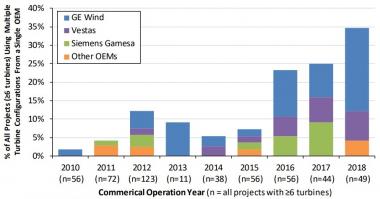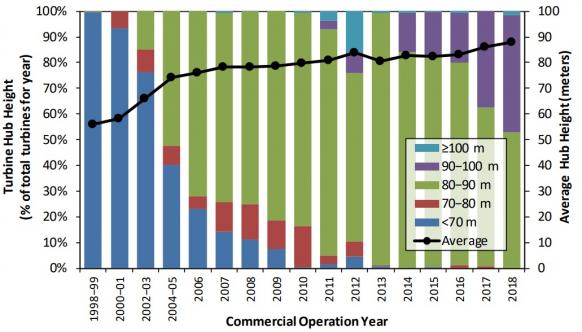Surge in mixed turbine wind farms tests capacity of service suppliers
Wind operators are increasingly turning to multiple turbine configurations to boost siting and revenue opportunities, raising new challenges in component sourcing and maintenance training, industry experts told New Energy Update.

Related Articles
Price pressure and dwindling site options are spurring many wind developers to install multiple turbine capacities at sites to maximize returns.
The percentage of U.S. wind power projects incorporating multiple turbine capacities from a single supplier hiked from 25% in 2017 to 35% in 2018, according to the Department of Energy's (DOE) recent Wind Technologies Market Report.
Most of these turbines "differed by all three of the major characteristics: hub height, rotor diameter, and capacity rating," DOE said.
US wind projects installing multiple turbine capacities
(Click image to enlarge)
Source: DOE's 2018 Wind Technologies market report (August 2019).
Larger, higher efficiency turbines can cut costs but raise fresh permitting and transport challenges.
Multiple turbine capacities can open up new turbine opportunities and allow operators to optimize specific site conditions. They also increase project complexity, testing installation and operations and maintenance (O&M) capabilities.
“From installation and O&M perspectives, having different turbine types in the same park usually only has disadvantages," Till Junge, Vice President, Product Strategy & Sales Support, Nordex Group, told New Energy Update. "Simply because it increases the variety of components within the facility.”
Extra revenue
Turbine capacities have grown rapidly in recent years but many sites do not permit the installation of the latest large-scale models.
"You could be near housing developments or next to flight paths,” Michael Taylor, Senior Analyst, International Renewable Energy Agency told New Energy Update.
“Smaller turbines within certain parts of the windfarm could be appropriate, and can be a good way to maximize the wind available," he said.
US average turbine height by installation year
(Click image to enlarge)
Source: DOE's 2018 Wind Technologies market report (August 2019).
Multiple turbine capacities can allow operators to optimize output across "micro-wind climates" within a particular site, Taylor said.
"This may be in terms of maximizing electricity generation or ensuring a more even generation profile," he said.
Nordex multiple turbine configuration deals include the supply of 104 turbines of capacity 4.5 MW turbines and 10 turbines of 3.9 MW to E.ON and Credit Suisse's Nysater wind project in Sweden.
Using a mixture of tower heights, the 4.5 MW turbines will be operated between 4.0 MW and 4.5 MW and the 3.9 MW models will be operated between 3.1 MW and 3.9 MW, Nordex said in December 2018.
"This optimization potential and ability to customize the turbine configuration, provides a huge advantage with large-scale projects like Nysater, where typically the wind conditions and complex topography vary greatly across the site," it said.
In another recent deal, Vestas received an order for V150-4.2 MW and V110-2.0 MW turbines for a 242 MW wind project in the US. Vestas would look to create a "tailor-made" site layout which would optimize the site’s wind resources, the company said.
In the U.S., qualification rules for the federal Production Tax Credit (or PTC) have accelerated demand for multiple turbine configurations. PTC incentives fall by 20% per year and "safe harbor" rules require developers to incur 5% of total project costs to qualify.
"In many cases, it's the dominant reason," Ryan Wiser, Senior Scientist and Group Leader of the Electricity Markets and Policy Group, Lawrence Berkeley National Laboratory, told New Energy Update.
"Developers purchase safe harbor turbines, then purchase more modern turbines later to fill out a project site. That’s another reason to develop mixed sites,” he said.
Wake control
Advances in data analytics and turbine operations are providing new tools to optimize total site output.
New wake control solutions are coming to market which allow operators to steer low-energy wind away from downstream units, increasing site output.
Earlier this year, technology group Emerson and A.I. data optimization specialist Vayu launched a commercial wind turbine control solution to reduce wake losses and increase site revenues.
Wake control strategies can increase output by as much as 10% at some sites, Jim Kiles, CEO of Vayu, told New Energy Update in June.
Sites with low wind velocity, changeable wind direction and high temperatures could see the greatest revenue gains, he said.
Service scope
The installation of assorted turbine capacities raises a range of construction and maintenance challenges.
Different sized blades may require different types of transportation along different routes, impacting construction efficiency, Taylor said.
Multiple turbine configurations also require more complex inventory management and equipment sourcing and greater training requirements.
“Overall, using different turbine capacities within a single plant will probably push up operation and maintenance (O&M) costs,” he said.
The growing trend of multiple configurations comes as O&M suppliers look to increase their share of the growing O&M market.
For example, Vestas agreed a 25-year service agreement as part of its recent 242 MW multi-configuration deal in the US.
"Using the same O&M provider (such as Vestas) can help minimize those extra costs," Taylor said. "But a lot depends on how good your supplier is, and what it’s prepared to offer you."
Growth driver
Corporate demand for renewable energy is on the rise but wind developers face growing competition from falling solar and storage costs. Multiple turbine configurations will help wind developers maximize project pipelines in the coming years.
By opting for a mixed capacity array, operators can find an optimal solution for the specific project need, Karin Ohlenforst, Director of Market Intelligence, Global Wind Energy Council, said.
“The idea of mixed turbines on sites that are maybe not the prime locations is definitely an opportunity for growth within a mature market such as Europe, where lots of the most usable sites are already taken,” Ohlenforst said.
By Ed Pearcey


